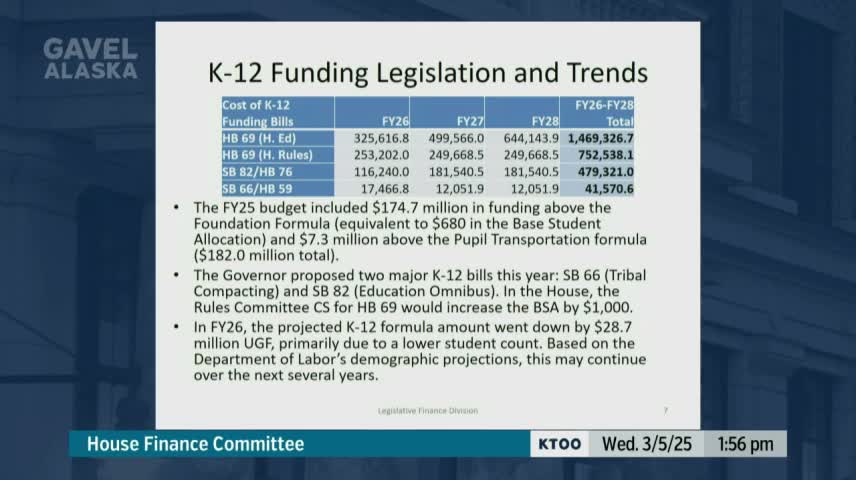Alaska governor proposes $200 million K-12 funding increase amid rising costs and enrollment decline
March 05, 2025 | 2025 Legislature Alaska, Alaska
This article was created by AI summarizing key points discussed. AI makes mistakes, so for full details and context, please refer to the video of the full meeting. Please report any errors so we can fix them. Report an error »

The Alaska State Legislature's House Finance Committee convened on March 5, 2025, to discuss significant funding proposals for K-12 education, focusing on the fiscal implications of various bills introduced by the governor. The meeting highlighted two major K-12 bills: House Bill 76, the education omnibus bill, and a tribal compacting bill, both of which carry substantial fiscal notes.
House Bill 76 is projected to cost $116 million in fiscal year 2026, increasing to $181 million in fiscal year 2027. The tribal compacting bill is estimated at $17 million for FY 2026 and $12 million for FY 2027. Together, these proposals indicate a potential total expenditure of approximately $200 million by FY 2027.
The committee also reviewed House Bill 69, which aims to increase the base student allocation (BSA). The House Education Committee's version proposed an increase of about $325 million for FY 2026, while the introduced version suggested a $1,000 increase in the BSA, amounting to $253 million. An amendment was adopted to include additional funding for reading proficiency incentive grants, adding another $22 million to the overall cost.
A critical point of discussion was the projected decline in K-12 funding due to a decrease in student enrollment, with an anticipated reduction of about $28.7 million in general funds. This decline is attributed to demographic shifts, with fewer children aged 0-5 compared to those aged 6-18, leading to a decrease in overall student population.
The committee examined the implications of these funding changes, noting that while the BSA is a key component of school funding, it does not capture the full financial picture. The shift towards correspondence students—who receive less funding than traditional brick-and-mortar students—has further complicated the funding landscape. The number of correspondence students has increased significantly, while enrollment in traditional schools has declined.
The meeting also addressed the impact of the hold harmless provision, which allows districts to retain funding despite losing a significant number of students. This provision has led to some districts receiving double funding in certain cases, particularly during the COVID-19 pandemic.
Overall, the discussions underscored the complexities of K-12 funding in Alaska, highlighting the need for careful consideration of both the fiscal implications of proposed legislation and the changing demographics affecting student enrollment. The committee's deliberations will inform future decisions regarding education funding and policy in the state.
House Bill 76 is projected to cost $116 million in fiscal year 2026, increasing to $181 million in fiscal year 2027. The tribal compacting bill is estimated at $17 million for FY 2026 and $12 million for FY 2027. Together, these proposals indicate a potential total expenditure of approximately $200 million by FY 2027.
The committee also reviewed House Bill 69, which aims to increase the base student allocation (BSA). The House Education Committee's version proposed an increase of about $325 million for FY 2026, while the introduced version suggested a $1,000 increase in the BSA, amounting to $253 million. An amendment was adopted to include additional funding for reading proficiency incentive grants, adding another $22 million to the overall cost.
A critical point of discussion was the projected decline in K-12 funding due to a decrease in student enrollment, with an anticipated reduction of about $28.7 million in general funds. This decline is attributed to demographic shifts, with fewer children aged 0-5 compared to those aged 6-18, leading to a decrease in overall student population.
The committee examined the implications of these funding changes, noting that while the BSA is a key component of school funding, it does not capture the full financial picture. The shift towards correspondence students—who receive less funding than traditional brick-and-mortar students—has further complicated the funding landscape. The number of correspondence students has increased significantly, while enrollment in traditional schools has declined.
The meeting also addressed the impact of the hold harmless provision, which allows districts to retain funding despite losing a significant number of students. This provision has led to some districts receiving double funding in certain cases, particularly during the COVID-19 pandemic.
Overall, the discussions underscored the complexities of K-12 funding in Alaska, highlighting the need for careful consideration of both the fiscal implications of proposed legislation and the changing demographics affecting student enrollment. The committee's deliberations will inform future decisions regarding education funding and policy in the state.
View full meeting
This article is based on a recent meeting—watch the full video and explore the complete transcript for deeper insights into the discussion.
View full meeting
